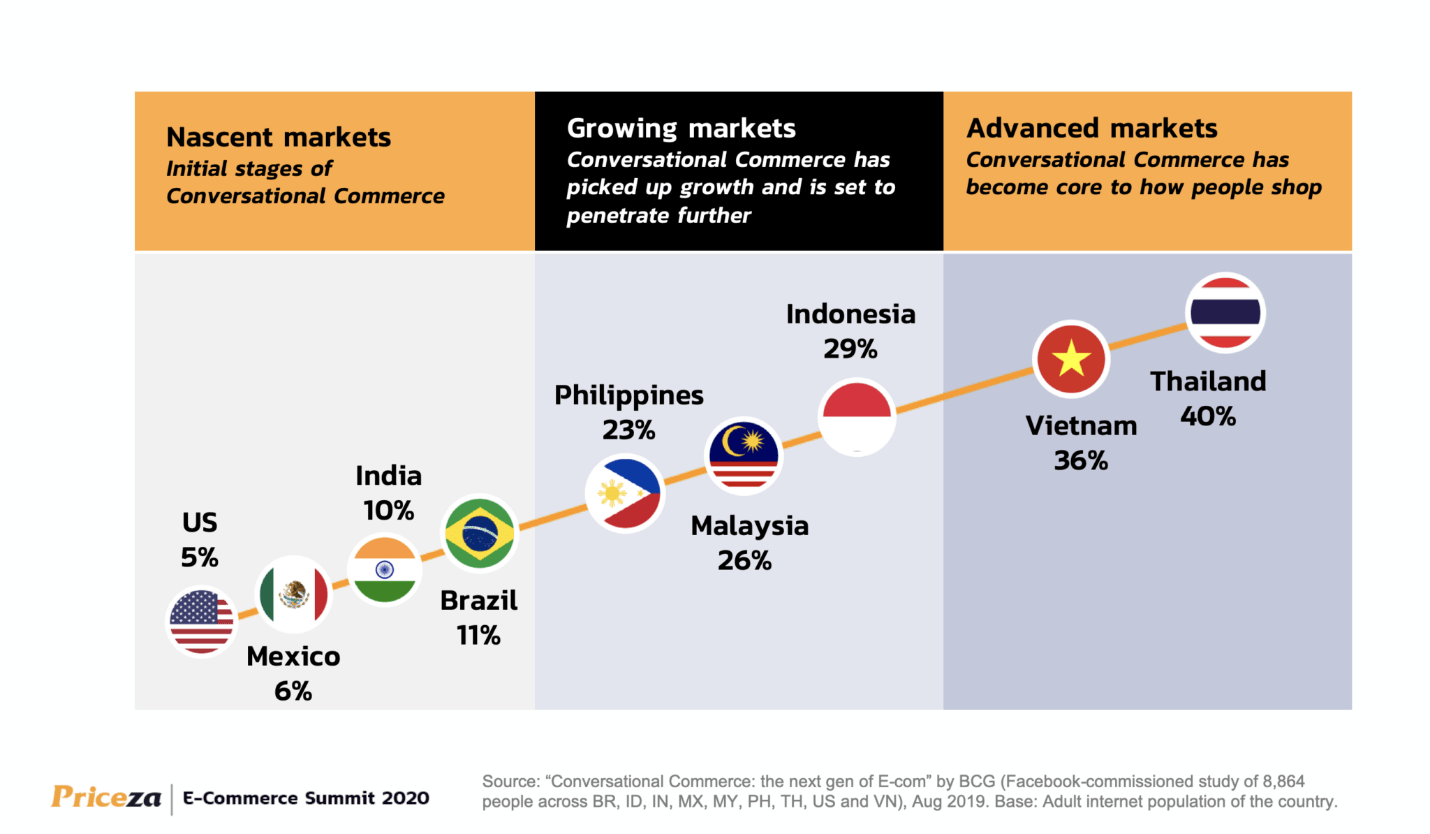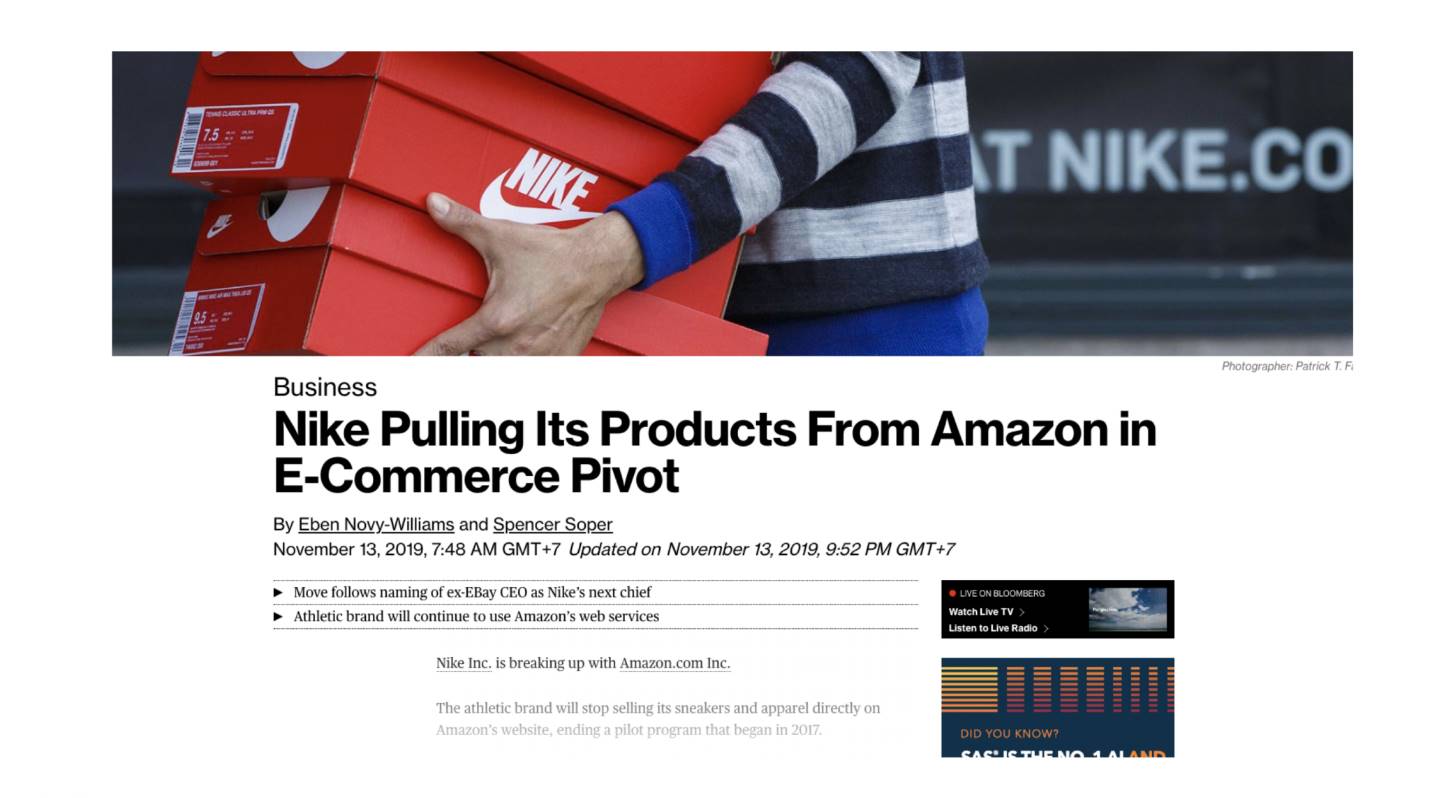The Growth of E-Commerce in Thailand is still growing rapidly and fiercely. The results of a survey on the growth of online trading (Social Commerce) in Thailand from the “E-Commerce Summit 2020” by Priceza showed the growth of small and large e-commerce businesses in Thailand by more than 40%, ranking number 1 among the countries surveyed (Figure 1).

And many statistics reveal that Thailand has fully entered the era of e-commerce. For marketers and digital agencies, these figures mean being prepared to deal with volatility and changing trends that each place must prepare for in order to provide guidance for adaptation to their entrepreneurs or clients. And for e-commerce businesses, these figures also mean increasing competition and a growing number of new competitors flooding into the Thai e-commerce market. In fact, we may hardly need to look at any statistics or numbers. Just sitting and looking at our Facebook timeline would probably show us that almost 60-70% of the information appearing on our timeline is advertisements from numerous e-commerce businesses, some of which are brands we like and some are competitors we have to overcome. As marketing tools themselves are growing to support this volatility, many people may start to feel restless and confused about where to start revolutionizing their e-commerce business to stand out and differ from competitors. Today, the Relevant Audience team comes with strategies to address this crisis promptly. Many people may have heard or heard the name of this strategy before. No problem. Today, we will start slowly with the strategy called ‘Vertical E-Commerce’ or ‘Vertical E-Commerce Business’ to reclaim the position of ‘darling’ and ‘only child’ for our business. We guarantee that it won’t be too difficult for you.
Let’s Understand Vertical E-Commerce (Vertical E-Commerce) First
Currently, e-commerce businesses can be broadly divided into 2 types: Horizontal E-Commerce businesses and Vertical E-Commerce businesses. For horizontal e-commerce businesses, the main concept is to sell a large number of products from a variety of categories. An example that many people are probably familiar with is the website Amazon.com, which sells almost everything in categories such as books, food, toys, furniture, etc. The products themselves come from their own brands and from other brands that Amazon allows to trade through its website. Due to the latter characteristic (allowing others to trade on their platform), Amazon and horizontal e-commerce businesses tend to resemble ‘marketplaces’. Other examples that Thais like us are probably more familiar with are Lazada or Shopee, which act as platforms for merchants and buyers to interact 24 hours a day. The word ‘horizontal’ refers to the expansive nature of product categories and in a way that the service provider (such as Amazon) does not produce, manage, or specialize in the products themselves, but acts as an expander of product and service categories for merchants and consumers. Most service providers are those who are willing to invest a large amount of money and are ready to develop platforms to support the number of people who will come to use them.
However, if you are just a person who likes makeup, clothing, or books, horizontal e-commerce businesses will certainly not be suitable for you. You don’t want to sell everything, but only ‘certain things’ that you are passionate about or specialize in. This different desire has led to another type of business called Vertical E-Commerce. The word ‘vertical’ refers to the development of a specific product category that is your highlight or expertise. A case study: An example of a brand that can boldly bring out its expertise and success is Hiut Denim, a jeans brand that comes with a unique and novel vertical business concept. The brand’s motto, ‘Do One Thing Well,’ and the bold and extreme declaration of their expertise through the first sentence on the website, ‘We make jeans. That’s it. Nothing else,’ not only creates the brand’s identity but also incorporates a successful vertical marketing approach (Figure 2).

Growth Trends, Strengths, and Benefits of Vertical E-Commerce
Of course, when talking about the value of e-commerce businesses, currently, many statistics are turning towards horizontal e-commerce or attempts to become marketplaces, which are growing increasingly massive. Especially in the context of e-commerce businesses in Thailand, where giants like JD Central, Shopee, and Lazada are starting to grow and accumulate huge profits. Survey results from the “E-commerce Trends 2020” seminar by Bangkok Bank and “Thailand E-Commerce Trends 2020″ by Priceza present consistent information that the trend of selling through E-Marketplace or online marketplace remains strong in Thailand and is an important channel for many small e-commerce businesses to transform themselves into more formal brands through the tools provided by these marketplaces.
But the growth of E-Marketplace also comes with factors that may reduce the popularity of being a marketplace. Many marketers studying the Thai e-commerce market trends agree that the growth of E-Marketplace over the past 2-3 years is because brands are in a period of investing and attracting merchants and consumers through a strategy of charging low sales fees for merchants, resulting in a large number of merchants flowing into the platform. And as brands grow, the service fees of E-Marketplace (for sellers) will certainly increase. As LINE@ has adjusted its service rates after great success in the Thai e-commerce market, resulting in many small service providers (who are not willing to pay service fees) deciding to stop providing services through that channel or temporarily, permanently, or invest at a lower rate, which affects management and sales.
The continued growth of E-Marketplace also means becoming the owner of vast amounts of consumer data that businesses within the marketplace cannot access. A key trend that many people predict is that many large (and small) brands will turn to direct marketing and sales to customers (or Direct to Customer) to compete for data ownership and space to build brand relationships and loyalty. Don’t forget that the marketplace platform will not favor brands to collect or interact in a closer manner than what the Direct to Customer strategy can do. When brands stop trading on the marketplace, the main trading will return to center on the brand’s main website or other channels of the brand. This means that the trading of brands will return to a vertical e-commerce business, management and image will be centralized and unified, easy to remember, and if able to bring out their strengths skillfully, building a loyal customer base will be less challenging. A case study example from Nike, which announced the end of selling products through Amazon, and turned back to build a customer base and trading on its own website and other main channels (Figure 3).

Consider Your Own Needs Before Revolutionizing
Nike’s decision to stop trading on Amazon.com is a step considered quite impactful for many other businesses that rely heavily on marketplaces. Many people are starting to wonder whether they should step out and create their own main platform in a vertical and direct (Direct to Customer) way. The answer is that if the size of your business is still small and lacks tools to access consumers, stepping out of the marketplace may be more of a disadvantage than an advantage. On the contrary, if you are managing a large brand, have potential, have a customer base, or want to offer a premium consumption experience to your customers, relying on a marketplace may destroy the opportunity to create a distinctive brand identity and direct customer access to the brand.
However, the vertical business concept is not necessarily incompatible with the marketplace platform. The heart of the revolution to e-commerce vertical does not lie in the characteristics of the platform itself, but in choosing the product categories that we can develop vertically (in depth) in a way of being an expert (even if the marketplace or other brands want to imitate). Planning content (Content Strategy) that will tell our uniqueness to impress consumers. Examples of successful vertical e-commerce businesses in Thailand or abroad include Pomelo selling fashion products or Konvy selling cosmetics only. Other strategies you can do in conjunction with developing a main brand website, and online communication channels, and constantly communicating and conveying the distinctive identity of the brand to consumers to absorb and be impressed.
Source:







